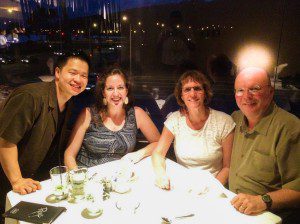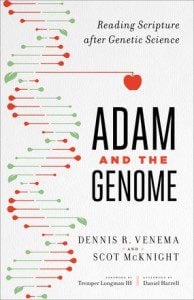 Aloha from Honolulu! (Actually, we arrive home Saturday from two wonderful weeks of teaching at Pacific Rim Christian University.) In the middle of which we met many new friends, including Joe and Jennifer Jung — Joe is a real Hawaii Five-O part of the HPD and Jennifer works with immigration. They took us out for a lovely dinner at Roy’s and graciously honored us with leis. [At least one in this family wonders if that glow was touched up.]
Aloha from Honolulu! (Actually, we arrive home Saturday from two wonderful weeks of teaching at Pacific Rim Christian University.) In the middle of which we met many new friends, including Joe and Jennifer Jung — Joe is a real Hawaii Five-O part of the HPD and Jennifer works with immigration. They took us out for a lovely dinner at Roy’s and graciously honored us with leis. [At least one in this family wonders if that glow was touched up.]
What Russ Moore said. Thanks!
Please read this about Jason Micheli and his family.
It’s often said that Britain’s church congregations are shrinking, but that doesn’t come close to expressing the scale of the disaster now facing Christianity in this country. Every ten years the census spells out the situation in detail: between 2001 and 2011 the number of Christians born in Britain fell by 5.3 million — about 10,000 a week. If that rate of decline continues, the mission of St Augustine to the English, together with that of the Irish saints to the Scots, will come to an end in 2067.
That is the year in which the Christians who have inherited the faith of their British ancestors will become statistically invisible. Parish churches everywhere will have been adapted for secular use, demolished or abandoned.
Our cathedral buildings will survive, but they won’t be true cathedrals because they will have no bishops. The Church of England is declining faster than other denominations; if it carries on shrinking at the rate suggested by the latest British Social Attitudes survey, Anglicanism will disappear from Britain in 2033. One day the last native-born Christian will die and that will be that.
These projections are based on the best available statistics: the censuses, the British Social Attitudes surveys and the British Election Study. But because these surveys are constructed differently, it’s not easy to crunch them into a single timeline. Crucially, a projection is not the same thing as a prediction. So feel free to take any apocalyptic vision of religion in Britain in 2067 with a pinch of salt. [HT: CHG]
There is an artificial line that splits the island of Hispaniola in two. On one side is Haiti, and on the other is the Dominican Republic.
There was a time when that split between the two countries was drawn with blood; the 1937 Parsley Massacre is widely regarded as a turning point in Haitian-Dominican relations. The slaughter, carried out by Dominican dictator Rafael Trujillo, targeted Haitians along with Dominicans who looked dark enough to be Haitian — or whose inability to roll the “r” in perejil, the Spanish word for parsley, gave them away.
The Dajabón River, which serves as the northernmost part of the international border between the two countries, had “risen to new heights on blood alone,” wrote Haitian American author Edwidge Danticat.
“The massacre cemented Haitians into a long-term subversive outsider incompatible with what it means to be Dominicans,” according to Border of Lights, an organization that commemorated the 75th anniversary of the massacre in 2012.
Today, things are as tense on the island as they have been in years. Within days, the Dominican government is expected to round up Haitians — or, really, anyone black enough to be Haitian — and ship them to the border, where they will likely be expelled.
NPR and Cambridge’s Professor of Lego.
How often to go to the doctor?
As doctors, we usually base the timing of follow-up visits on some mix of habit and a gestalt of patient need, all within the arbitrary structure of the lunar calendar. Not surprisingly, then, Dartmouth researchers have shown that visit rates vary tremendously. In a study of Medicare data, they found that seniors in Grand Forks, N.D., average less than three visits each year, while those in East Long Island, N.Y., go to the doctor as many as 12 times a year on average. Patients tend to have more visits per year if they are sicker, the study found, but also if they live in an area with more doctors or with doctors who tend to ask patients to come in more often, even when adjusting for factors such as health status. What the patient prefers seems to have no significant association with visit rates.
The timing of follow-up visits, in other words, has tended to fall under the art, rather than the science, of medicine. While studies suggest that connecting with a doctor is generally a good way to build a trusting relationship and to promote health, we don’t really know the right frequency of visits. The few studies that exist on the subject pertain to specific conditions, such as kidney failure: In one observational studyof patients on hemodialysis, patients who had four visits per month had the same risk of death and only a slightly lower risk of hospitalization in the following year compared with those who had less-frequent visits. Several other studies, of prenatal care, for instance, have found that fewer visits may be just as good.
There are three kinds of people in the world: Those who walk, those who run, and those who text. It’s a recipe for a traffic jam.
Utah Valley University, a school of about 30,000 students based in Orem, Utah, thinks it has a solution — designated lanes. The staircase at the school’s new student life and wellness center is carved up into three sections, one for each type of intrepid climber.
The lanes are mostly there for looks and laughs, the school’s creative director Matt Bambrough told Time. Unfortunately, “most people don’t obey the posted lanes,” he said. But Bambrough’s not the only person who thinks that texters need their own space on the sidewalk. Earlier this week the Internet was agog over a similar project in the Belgian city of Antwerp, where a mobile phone repair company had painted a narrow “text walking lane” onto several streets.
Children’s brains and green spaces:
When it comes to the physical and psychological benefits of being exposed to nature — and especially to scenery that is filled with lush plant life — the evidence lately has been rolling in.
Recently we reported on a study by Australian researchers showing that brief 40 second micro-breaks, in which students looked at computerized images of a green roof, led to improved performance on an attention-demanding cognitive task.
And now, in what appears to be the first study of its kind, a team of researchers find myriad additional benefits for schoolchildren who go to schools that feature lots of green spaces and natural scenery. Kids exposed to more greenery — as measured by satellite imagery of their schools and neighborhoods — showed not only better attention, but also superior working memory.
In recent years there have been a lot of articles about the importance of teaching children empathy. As a psychotherapist (and a mom) who specializes in relationships, I could not agree more. I am hopeful that the emphasis on empathy will help children become happier people with more fulfilling relationships. On a larger scale, I hope a focus on empathy will make the world a better and more compassionate place.
However, I also believe that teaching our children assertiveness is just as important as teaching empathy. I like to call the balance of being a kind and empathic person while also being a person that is firm, self-assured and confident, “empathic assertiveness.” Empathic assertiveness means that we respect others and can see their perspective, but at the same time we’re firm in our boundaries and are confident in how we implement them.
In my practice, I often see confusion of how empathy and assertiveness can harmoniously work together. I see parents who appreciate empathy but have apprehension towards it and I also see people who act out of empathy but often to their own detriment. Because of this, I have come to realize that empathy is often thought of as being mutually exclusive from assertiveness.
The ultimate organic burial — go to the link to see images:
Coffins, tombstones and normal funeral proceedings are so last year…. This unconventional way of being buried might just be the future. This unique burial method originated in Italy and is titled The Capsula Mundi project created by designers Anna Citelli and Raoul Bretzel. The designers created an organic, biodegradable burial capsule that actually transforms the body of the deceased into a tree. As this occurs, the body would turn into nutrients for the tree that would allow it to grow.
Coffee drinkers throughout the world:
Coffee, the bitter beginning to so many people’s mornings, has been enjoyed by humans since at least the 13th century when the first roasted coffee was served. Today, the world drinks somewhere upward of 2 billion cups each day. People kill for it. And sue multimillion dollar corporations over it. We even named a piece of living room furniture for its association with coffee, despite the fact that everyone knows the table is just for propping up your feet.
Given the primacy of coffee in our daily lives, we decided to chart and map some of the finest data on the world’s coffee habits — who drinks it, how we drink it, and how much we guzzle on a daily basis.
 On Wednesday evening Kris and I dined with Rick and Martha Stinton along with Mark and Stephen, who was my TA while here at Pac-Rim. Wonderful dinner at Duke’s.
On Wednesday evening Kris and I dined with Rick and Martha Stinton along with Mark and Stephen, who was my TA while here at Pac-Rim. Wonderful dinner at Duke’s.












